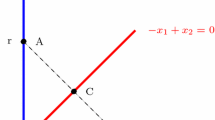Abstract.
Lagrangian relaxation is often an efficient tool to solve (large-scale) optimization problems, even nonconvex. However it introduces a duality gap, which should be small for the method to be really efficient. Here we make a geometric study of the duality gap. Given a nonconvex problem, we formulate in a first part a convex problem having the same dual. This formulation involves a convexification in the product of the three spaces containing respectively the variables, the objective and the constraints. We apply our results to several relaxation schemes, especially one called “Lagrangean decomposition” in the combinatorial-optimization community, or “operator splitting” elsewhere. We also study a specific application, highly nonlinear: the unit-commitment problem.
Similar content being viewed by others
Author information
Authors and Affiliations
Additional information
Received: June 1997 / Accepted: December 2000¶Published online April 12, 2001
Rights and permissions
About this article
Cite this article
Lemaréchal, C., Renaud, A. A geometric study of duality gaps, with applications. Math. Program. 90, 399–427 (2001). https://doi.org/10.1007/PL00011429
Issue Date:
DOI: https://doi.org/10.1007/PL00011429




